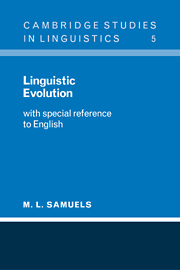Book contents
- Frontmatter
- Contents
- Preface
- Note to second impression
- Abbreviations
- 1 Introduction
- 2 Variation in the spoken chain
- 3 System: the phoneme
- 4 Grammar and lexis (I): variation
- 5 Grammar and lexis (II): systemic regulation
- 6 Diversity and contact
- 7 An assessment of the problem
- 8 Dimensions of study
- 9 Conclusions
- Bibliography
- Index of persons
- Index of subjects
- Plate section
- Frontmatter
- Contents
- Preface
- Note to second impression
- Abbreviations
- 1 Introduction
- 2 Variation in the spoken chain
- 3 System: the phoneme
- 4 Grammar and lexis (I): variation
- 5 Grammar and lexis (II): systemic regulation
- 6 Diversity and contact
- 7 An assessment of the problem
- 8 Dimensions of study
- 9 Conclusions
- Bibliography
- Index of persons
- Index of subjects
- Plate section
Summary
Introductory
Although an attempt was made above to show that all linguistic change can be accommodated within a single framework, this is not to deny that great variety of change can exist within it. Pressures towards change can be strong or weak (5.5, p. 80), and for this reason alone, some changes can be expected to take place over a limited period (say, fifty years), whereas others may be more protracted and last for anything up to a millennium. Still further variations follow from the complexity of conflicting pressures.
Secondly, the scholar's viewpoint will to some extent depend on where he decides to make the ‘cut’ from the total history. In lexis, many cases of selection form part of a continual process of loss and replacement (with accompanying resolution of ambiguities), and for this process it is often impracticable or unnecessary to make any ‘cut’ at all. In other cases, he may be guided by objective reasons (e.g. the absence of any apparent prelude or sequel, in a well-documented period of the language) to the points he chooses for the start or end of a change. The nature of the evidence (or lack of it) may limit the study of a change either in time or scope, so that it turns out to be restricted, say, to a single subsystem over a long period, or to all subsystems over a shorter period.
- Type
- Chapter
- Information
- Linguistic EvolutionWith Special Reference to English, pp. 154 - 176Publisher: Cambridge University PressPrint publication year: 1972

